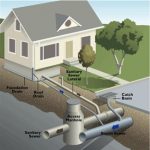Gravity Systems
These sewers, known as conventional gravity sewers, are designed so that the slope and size of the pipe is adequate to maintain flow towards the discharge point without surcharging manholes or pressurizing the pipe. Sewers are commonly referred to according to the type of wastewater that each transports. For example, storm sewers carry storm water; industrial sewers carry industrial wastes; sanitary sewers carry both domestic sewage and industrial wastes.
Another type of sewer, known as a combined sewer, is prevalent in older communities, but such systems are no longer constructed. Combined sewers carry domestic sewage, industrial waste, and storm water.
Conventional gravity sewers are typically used in urban areas with consistently sloping ground because excessively hilly or flat areas result in deep excavations and drive up construction costs. Conventional gravity sewers remain the most common technology used to collect and transport domestic wastewater.
Types
1) Building Sewers are what connect a building’s internal wastewater collection system to the municipal sewer system. They can connect to a lateral, main or trunk sewer line.
2) Lateral and Branch Sewers are the upper ends of the municipal sewer system. Laterals dead-end at their upstream end with branch sewers collecting the wastewater from several lateral sewer lines.
3) Main Sewers are collectors for numerous lateral and branch sewers from an area of several hundred acres or a specific neighborhood or housing development. They convey the wastewater to larger trunk sewer lines, to lift stations or to a neighborhood package wastewater treatment plant.
4) Trunk Sewers serve as the main arteries of the wastewater collection system. They collect and convey the wastewater from numerous main sewer lines either to a wastewater treatment plant or to a interceptor sewer.
5) Interceptor Sewers receive the wastewater numerous from trunk sewers and convey it to a wastewater treatment plant. These are the largest diameter lines in the sewer system and the furthest downstream in the system.
Conventional gravity sewer systems have been used for many years and procedures for their design are well-established. When properly designed and constructed, conventional gravity systems perform reliably. Properly designed and constructed conventional gravity sewers provide the following advantages:
• Can handle grit and solids in sanitary sewage.
• Can maintain a minimum velocity (at design flow), reducing the production of hydrogen sulfide and methane. This in turn reduces odors, blockages, pipe corrosion, and the potential for explosion (Qasim 1994).
Disadvantages
• The slope requirements to maintain gravity flow can require deep excavations in hilly or flat terrain, driving up construction costs.
• Sewage pumping or lift stations may be necessary as a result of the slope requirements for conventional gravity sewers, which result in a system terminus (i.e., low spot) at the tail of the sewer, where sewage collects and must be pumped or lifted to a collection system. Pumping and lift stations substantially increase the cost of the collection system.
• Manholes associated with conventional gravity sewers are a source of inflow and infiltration, increasing the volume of wastewater to be carried, as well as the size of pipes and lift/pumping stations, and, ultimately, increasing costs.
The design of conventional gravity sewers is based on the following design criteria:
• Long-term serviceability.
• Design flow (average and peak).
• Minimum pipe diameter.
• Velocity.
• Slope.
• Depth of bury and loads on buried conduits.
• Appurtenances.
• Site conditions.
The design of long-lived sewer infrastructure should consider serviceability factors, such as ease of installation, design period, useful life of the conduit, resistance to infiltration and corrosion, and maintenance requirements. The design period should be based on the ultimate tributary population and usually ranges from 25 to 50 years.

